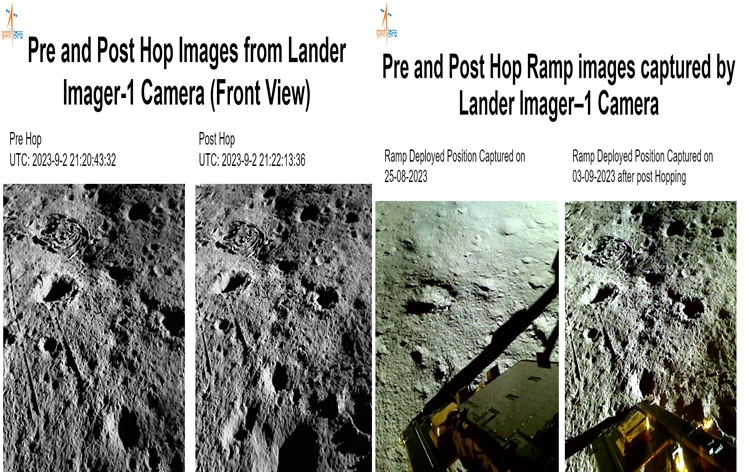ISRO's Chandrayaan-3 Vikram Lander Soars to New Heights with 'Hop Experiment

The Indian Space Research Organisation (ISRO) continues to captivate the world with its remarkable achievements in space exploration. After successfully achieving a soft landing on the Moon's South pole on August 23, ISRO has been on a roll, sharing intricate details of the Chandrayaan-3 mission that have left space enthusiasts in awe.
In a recent development, ISRO unveiled the results of a groundbreaking experiment involving the Vikram Lander. The mission's latest feat, known as the 'hop experiment,' has opened up exciting possibilities for the future of lunar exploration.
The 'hop experiment,' as explained by ISRO, involved a carefully orchestrated maneuver. On command, Vikram Lander fired its engines, lifting itself approximately 40 centimeters above the lunar surface before safely descending to a location just 30 to 40 centimeters away. This precision-engineered hop demonstrates the spacecraft's exceptional capabilities and sets the stage for further ambitious missions, including sample returns and human exploration.
ISRO, in a statement, emphasized the importance of this "kick-start" maneuver in advancing lunar exploration. By mastering this technique, ISRO is positioning itself to study future sample returns and prepare for human missions to the Moon.
A key highlight of this achievement is the impeccable performance of all systems involved. The Ramp, ChaSTE, and ILSA instruments, which played crucial roles in the experiment, were folded back and redeployed successfully, attesting to the mission's flawless execution.
While the Vikram Lander celebrated its successful hop, the Pragyan Rover embarked on its own lunar adventure. Having traversed over 100 meters on the Moon's surface, the rover conducted a series of operations, including a temperature profile analysis of the lunar landscape. Notably, traces of Sodium were detected, adding to the growing body of lunar scientific knowledge.
As Pragyan Rover completes its assignments, it has been temporarily placed in sleep mode, awaiting further instructions from mission control.
In addition to the Chandrayaan-3 mission's accomplishments, ISRO reached another milestone with the launch of its first-ever solar mission, 'Aditya-L1,' from Sriharikota on September 2. This mission is set to deepen our understanding of the Sun and its crucial role in the solar system.
ISRO's relentless pursuit of excellence and its commitment to pushing the boundaries of space exploration continue to inspire not only India but the entire world. With each achievement, ISRO's vision for space exploration becomes clearer, and the possibilities for the future seem boundless.
